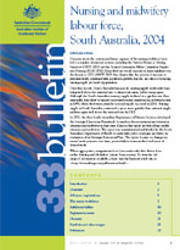Nursing and midwifery labour force, South Australia, 2004
Citation
AIHW
Australian Institute of Health and Welfare (2006) Nursing and midwifery labour force, South Australia, 2004, AIHW, Australian Government, accessed 24 April 2024.
APA
Australian Institute of Health and Welfare. (2006). Nursing and midwifery labour force, South Australia, 2004. Canberra: AIHW.
MLA
Australian Institute of Health and Welfare. Nursing and midwifery labour force, South Australia, 2004. AIHW, 2006.
Vancouver
Australian Institute of Health and Welfare. Nursing and midwifery labour force, South Australia, 2004. Canberra: AIHW; 2006.
Harvard
Australian Institute of Health and Welfare 2006, Nursing and midwifery labour force, South Australia, 2004, AIHW, Canberra.
PDF | 576Kb
Concerns about the current and future capacity of the nursing workforce have led to a number of national reviews, including the National Review of Nursing Education (DEST 2002) and the Senate Community Affairs Committee Inquiry into Nursing (SCAC 2002). Data show an overall increase in nurse numbers over the decade to 2003 (AIHW 2003) but, despite this, the pattern of increase in part-time work, combined with population growth, had the net effect of reducing nursing supply per head of population. Over that decade, South Australia has seen its nursing supply levels shift from being well above the national rate to almost the same, before rising again. Although the South Australian nursing supply declined at a quicker rate than nationally, data show it has also recovered sooner, experiencing its lowest point in 1999, while the lowest point for national supply occurred in 2001. Nursing supply in South Australia continued to grow more quickly than national supply and was again well above the national rate by 2003.
- ISSN: 1446 9820
- ISBN: 978 1 74024 541 8
- Cat. no: AUS 70
- Pages: 24



